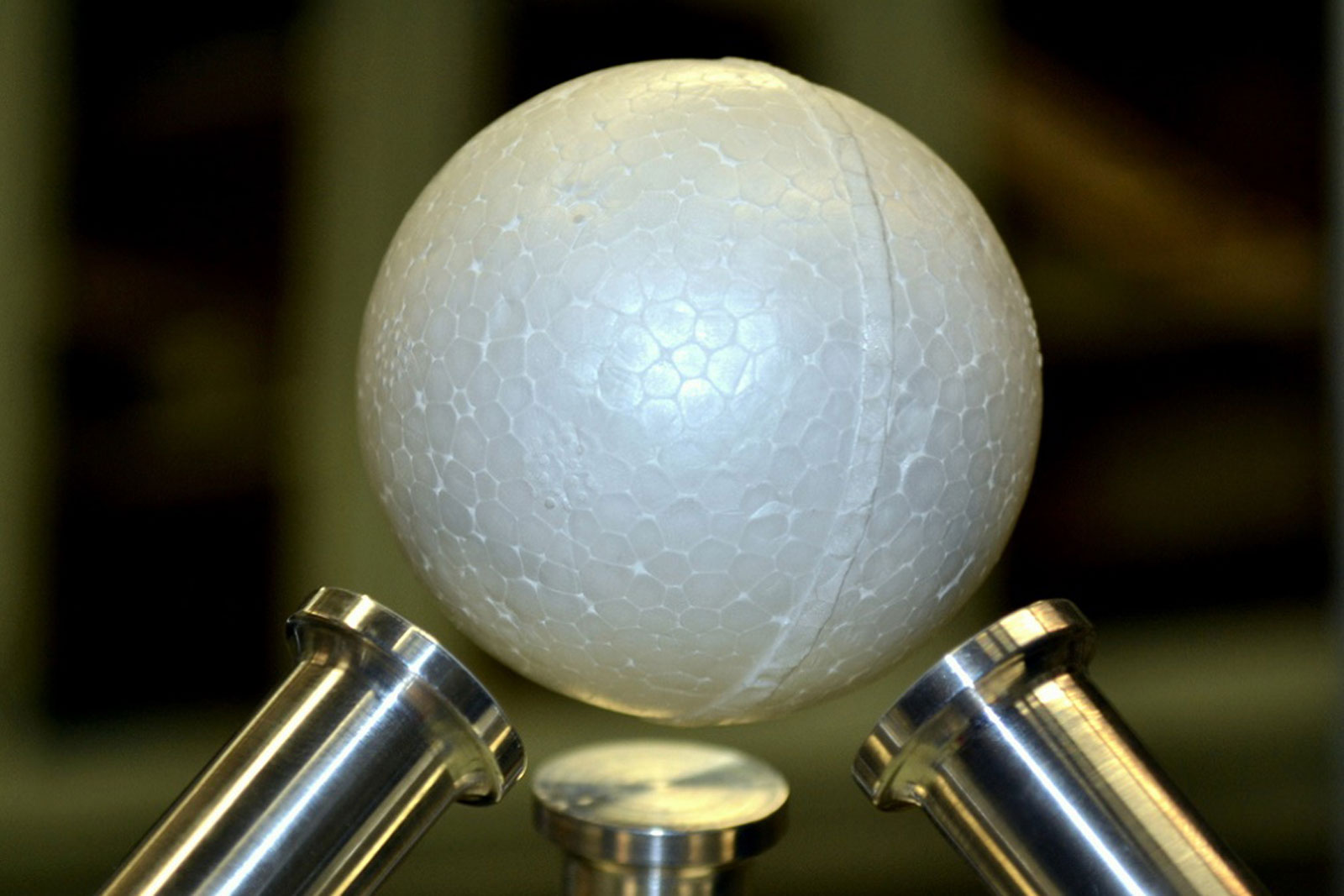
Holograms are three dimensional images that have been projected via the manipulation of light. Yet the question remains whether a hologram can be made through sound?In fact, the answer to this is a...
 Scientists have long dreamed of using acoustic levitation to float objects, but there has been one big catch: you couldn't lift an object larger than the wavelength without being picky about what you're lifting. However, it might not be a problem go...
Scientists have long dreamed of using acoustic levitation to float objects, but there has been one big catch: you couldn't lift an object larger than the wavelength without being picky about what you're lifting. However, it might not be a problem go...
 For all the benefits that the Global Positioning System provides to landlubbers and surface ships, GPS signals can't penetrate seawater and therefore can't be used by oceangoing vehicles like submarines or UUVs. That's why DARPA is creating an acoust...
For all the benefits that the Global Positioning System provides to landlubbers and surface ships, GPS signals can't penetrate seawater and therefore can't be used by oceangoing vehicles like submarines or UUVs. That's why DARPA is creating an acoust...
 Today on In Case You Missed It: Lockheed Martin is encouraging kids to get into STEM with a Mars Experience Bus, with giant displays that look as though they're actually driving on the surface of Mars. Rice University created nanotubes that quickly...
Today on In Case You Missed It: Lockheed Martin is encouraging kids to get into STEM with a Mars Experience Bus, with giant displays that look as though they're actually driving on the surface of Mars. Rice University created nanotubes that quickly...
I love speakers, but I have to say that I’m impressed by some of the acoustic amplifiers that have been made for iPhones and iPads over the years. They certainly do amplify the sound, and it’s always surprising how loud the resulting sound can be. Check out this gramophone acoustic speaker, which will be a perfect contrast to your shiny new iDevice.
The Gramophone for iPhone & iPad is available from Restoration Hardware. You simply set your device into its handcrafted, solid wood base. The iron and brass horn will amplify the volume of your iDevice by three to four times.
Prices vary from $199 to $299 (USD), and you can decide between walnut and dry oak, in sizes that will fit your iPad or iPhone.
[via Uncrate]
The HTC One has been a pleasant phone to own, ever since I upgraded from my iPhone. But I have to say that I’ve never considered adding on a pair of 3D-printed speakers that cost thousands of dollars. These speakers look interesting, but they’ll cost you quite a bit of cash.
The Gramohorn II speakers are designed to amplify the sound of your HTC phone. They were based on a commission by HTC UK from Justin Wolter. They are supposed to be able to boost the HTC’s included speakers’ volume by 50%.
Gramohorn II works with the HTC One family of phones, from the HTC One, the HTC One Mini and the HTC One Max, thanks to a changeable cradle. The plaster resin version will cost you approximately $1,610(USD) while the milled stainless steel version will fetch a whopping $8,030.
[via Ubergizmo]
I’ve seen lots of acoustic amplifier add-ons for smartphones, but never any that are quite as cool looking as these. Symphony Shells are 3D printed acoustic amplifiers which are reminiscent of marine life.

The organic shapes serve not only to amplify sound, but to add a touch of nautical style to your phone while docked. They come in a variety of shapes, colors and sizes, ranging from the $45 (USD) Urchin :: solo (shown in green above), which boosts your phone’s speaker by about 12db, to the $95 Murex :: solo (shown in orange), which increases volume by 16db, up to the $165 Nautilus :: solo (shown in blue), and boosts volume by 19db. All three designs are also available in the “ensemble” variants which infuse multicolored designs onto the shells.
Simply Amplified, the team behind the Symphony Shells is currently raising funds for production of the line – to be made out of fully-recyclable 3D printed materials. The docks will be compatible with a wide variety of smartphones, including iPhone 3G/3GS/4/4S/5, Samsung Galaxy SII/SIII/Note II, Nokie Lumia 920, HTC Droid DNA and Motorola Droid Razr MAXX models
If you’d like to get in on the action, head on over on Kickstarter and pledge. Early supporters of the Symphony Shells save $10 to $20 on the designs compared to the retail prices mentioned above.
Late last week, Moog outed its LEV-96 sensoriactuator prototype and offered a glimpse at its latest R&D unit. Even though it's still in the early phases of beta-testing, we were able to stop by the Moog Music factory for a closer look and a brief glimpse of the gear in action ahead of its appearance at Moogfest. While the unit is installed on acoustic guitars for the time being, the company says that similar tech can be used on other acoustic instruments and eventually to other surfaces -- this is just the current manifestation. Since the tech modifies the guitar's natural harmonics and string vibrations, the LEV-96 is getting cozy on both traditional acoustic guitars and those outfitted with pickups in its present state.
As far as controls go, the entire unit is capacitive touch-enabled from the moment a finger swipe powers it on. Sliders allow for adjusting the intensity, harmonics and note duration while the other buttons enable arpeggio presets and modulation that includes tremolo and random harmonic tweaks. Those sliders remain in play when a preset is activated, serving to enable further adjustments on selected There is a lock button, too, so that you don't accidentally make a switch mid-strum. All of these finger-friendly surfaces work alongside two pairs of electromagnetic pickup channels per string to wrangle the 96 simultaneous harmonics. Magnets work to either increase of decrease the string's motion, bringing out vibrational modes that have always been in-play on acoustic instruments, but have never been offered the power needed to make 'em sing. The folks at Moog are quick to remind us that the LEV-96 is still in its infancy, but you can rest assured we'll be keeping an eye our for what develops. For a peek at the tech in action, head on past the break for a really quick demo that we kept brief due to that fact that this is an early prototype.
Filed under: Misc
Moog's LEV-96 sensoriactuator prototype wields touch control of 96 simultaneous harmonics, we go eyes-on (video) originally appeared on Engadget on Thu, 25 Oct 2012 15:40:00 EDT. Please see our terms for use of feeds.
Permalink | | Email this | Comments Technologies like NFC, RFID and QR codes are quickly becoming a normal part of everyday life, and now a group from
It's easy to see how smartphones could take advantage of this -- not that we recommend dragging your new iPhone over ridged surfaces -- but unlike the technologies mentioned earlier, not all potential applications envisage a personal reading device. Dot barcodes around an area, install the sound processing hardware on site, and you've got yourself an interactive space primed for breaking freshly manicured nails. We're pretty impressed by the simplicity of the concept, and the team does a good job of presenting scenarios for implementing it, which you can see in the video below. And, if you'd like to learn a little more about the idea or delve into the full academic paper, the source links await you.
[Thanks, Julia]
Continue reading Acoustic barcodes store data in sound, go on just about anything (video)
Filed under: Cellphones, Misc, Software, Alt
Acoustic barcodes store data in sound, go on just about anything (video) originally appeared on Engadget on Sat, 13 Oct 2012 00:57:00 EDT. Please see our terms for use of feeds.
Permalink Hack a Day |
Hack a Day |  Chris Harrison (1), (2) (PDF) | Email this | Comments
Chris Harrison (1), (2) (PDF) | Email this | Comments Passive speakers have come a long way since they started appearing, and I have to say that this one does look pretty appealing. It’s basically a solid hunk of wood, but it’s not too big to be unwieldy.

The Sounder packs a warm natural look, and it’s made out of 100% reclaimed wood that’s been fashioned by hand by the New York-based designer Howard Fink. There is a slot that will hold your tablet or smartphone, which directs the sound through a carved horn. It’s supposed to work pretty well and mimics the human mouth in its shape. Howard is also using some specialized wood, from 19th century buildings and from the Coney Island boardwalk to make each one.

The Sounder was launched as a project through Kickstarter, though it has only raised $8,000 out of a $50,000 goal with less than three days left. It doesn’t look like it will get funded, but maybe you’ll see the Sounder pop up on Etsy at some point.

[via DVice]